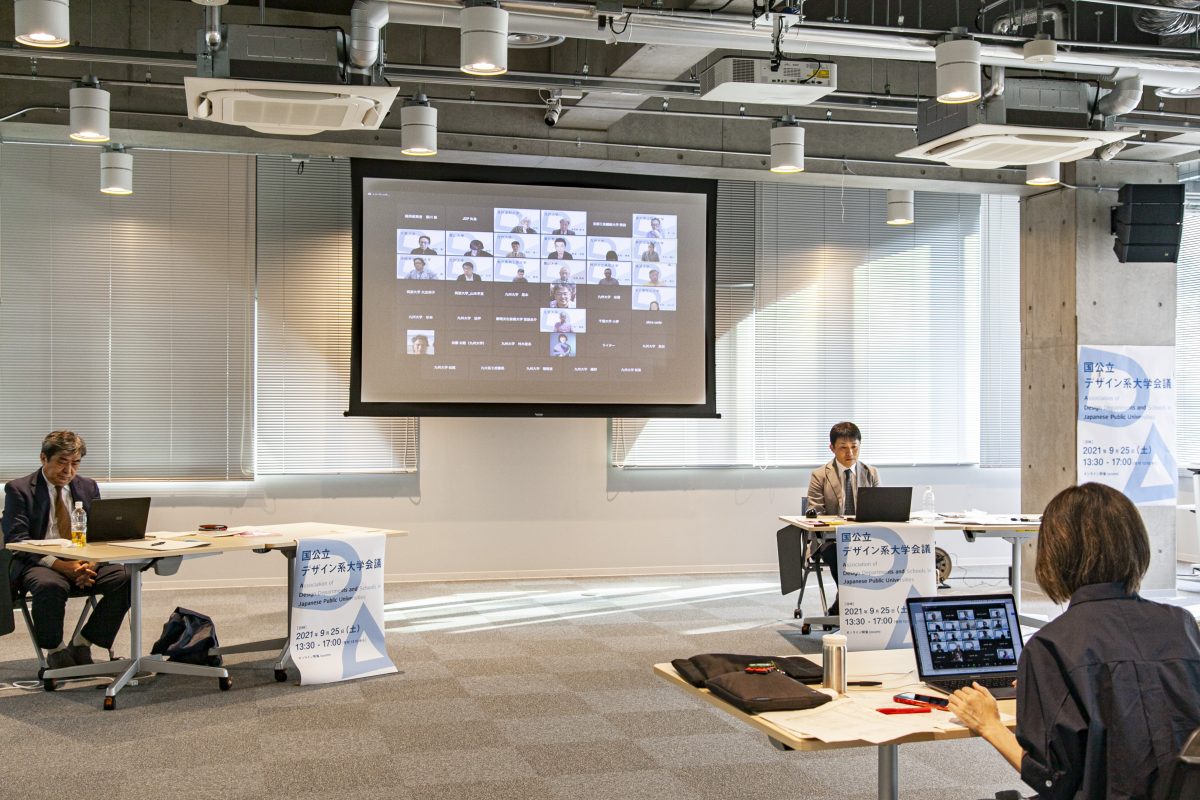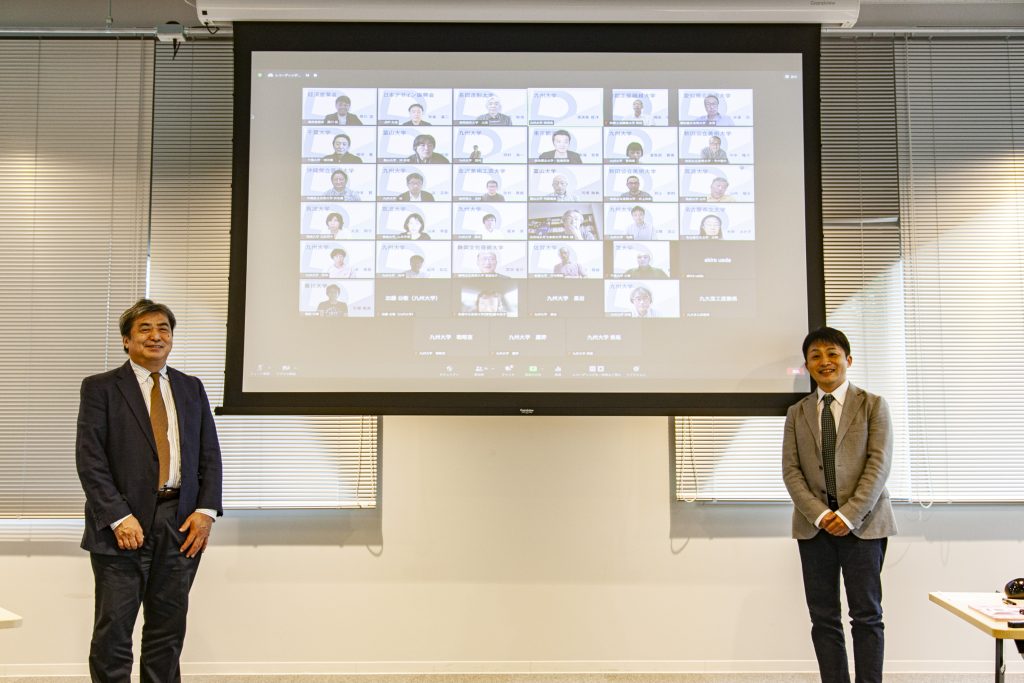ReportsThe 3rd Association of Design Departments and Schools in Japanese Public Universities Conference2021.9.25

The Association of Design Departments and Schools in Japanese Public Universities Conference gathers 22 public universities with design-related faculties and departments. On this day, 17 of these universities gathered for the third symposium, which was held online. In 2021, the pandemic that began the previous year had not been resolved, and the state and methods of education at universities continue to be questioned. Under the overall theme of “New Normal: New Relationship between Society and Design”, case studies from each university were shared, and a lively Q&A session was held under the sub-theme of “Student”, “Region”, and “International”.
In the first half of the session, the three universities shared their case studies. Nagaoka Institute of Design, the Okinawa Prefectural University of Arts and the University of Tsukuba made presentations on how they are implementing design education after the coronavirus pandemic under the theme of “Students”, “Regional”, and “International”, respectively.
The Association of Design Departments and Schools in Japanese Public
Nagaoka Institute of Design
How Do We Conduct Exercises with the Community?
Professor Tomoya Tsuchida of the Nagaoka Institute of Design, Department and Graduate School of Design gave a presentation on the “Regional Collaboration Exercises”, in which undergraduate students work together with the local community. Every year, about 10 projects are carried out, and although the number of projects decreased slightly in 2020 due to the coronavirus countermeasure, it returned in 2021, with 3 to 36 students participating in the exercises of their choice. One of the projects, the “Hirei Scarecrow Project”, involves students proposing designs for scarecrows to be installed in rice paddies and then actually installing them. As it was an outdoor exercise, this initiative was carried out as in previous years. He shared that they would continue to implement this project every year, and it is recognized as a community event, even including the social gathering after the event Ano ther example mentioned was the “Household Goods Development Project”, an exercise in which students proposed a new product to a storage furniture manufacturer in Tsubame-Sanjo City in 2021 and repeatedly made prototypes to commercialize the product. So far, the project has resulted in several commercialized products, and the students are highly motivated. The actual meeting with the manufacturer is a hybrid of online and face-toface. Students, faculty members, and the manufacturer’s representative are grouped in Line groups as appropriate, which enables smooth communication. Professor Tsuchida concluded his presentation by saying that while the two-year pandemic has helped establish teaching methods, there are still issues to be addressed regarding students’ campus life, such as the implementation of club activities and events. He concluded his presentation by saying that he would like to find a way to avoid restrictions on students’ voluntary activities. Ability to survive flexibly according to the situation without losing heart even in difficult times.
Okinawa Prefectural University of Arts
Design Education in Okinawa, Greatly Influenced by Coronavirus
Professor Masaru Nakamoto of the Faculty of Arts and Crafts and the Graduate School of Formative Arts at the Okinawa Prefectural University of Arts gave a presentation on how the university, as the only design university in Japan located in a subtropical region, is implementing design education that is closely connected to the local community. While running many projects, it also provided a glimpse of the difficulties unique to Okinawa, which was strongly affected by the pandemic. Professor Nakamoto acknowledged that remote teaching was not very successful in Okinawa and explained that many projects had to be cancelled or postponed, such as the “Mobile University”, which took students to remote islands to conduct workshops, the “Development of Local Specialties”, which took students into the local community to utilize their own specialties, and the “Support for the Development of Local
Products by Junior High School Students”, which involved collaboration with junior high school students and local companies. On the other hand, he said that the coronavirus pandemic had made many things remote, which has opened new possibilities. As an example, he shared that there have been unprecedented developments, such as requests from local companies to open design education courses and requests to open design-related courses with sister schools in Taiwan and Indonesia. The communication with students has also changed. Although we have been able to build a good relationship with the students in the lecture-style classes on a one-to-one basis, we are still having difficulties managing the practical subjects and fieldwork.
University of Tsukuba
How Do We Provide Remote International Education in the Coronavirus Pandemic?
Professor Toshimasa Yamanaka of the University of Tsukuba’s School of Art and Design and Graduate School of Comprehensive Human Sciences said
that the most important job of a designer is to “make visible issues that are not yet visible to people”, and that what will be essential in today’s globalized
world is to create challenges by competing with various kinds of knowledge about new modes of human social existence. As specific initiatives, he introduced the “Tsukuba Global Science Week 2020” and the “Campus in Campus = CiC Concept”. In particular, he discussed the subject, “jukebox”, which aims to develop and operate courses to be shared among CiC partner universities, and how it is important to provide design education programs on an international online education platform and open it to overseas. He also recognized that this initiative would contribute to the Ministry of Education, Culture, Sports, Science and Technology’s “Forum for Promoting Internationalization of Universities in the New Normal” and the “Online International Education Platform Project” (tentative name: Japan Virtual Campus). Next, Associate Professor Kuniko Otomo of the same university gave a presentation on the practice of the “Online International Collaborative Exercise with Politecnico di Milano”. She shared the importance of identifying the strengths of both online and offline, team-building techniques, and securing opportunities for actual production work through a two-year remote exercise connecting Tsukuba and Milan.
Exchange of Opinions
Each university expressed their opinions on the theme of this year’s conference, “New Normal: New Relationship between Society and Design”, as well as on the keywords, “student”, “community”, and “international”.

